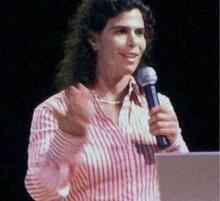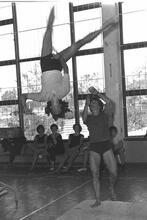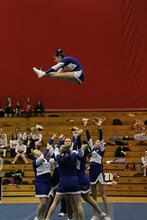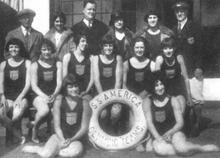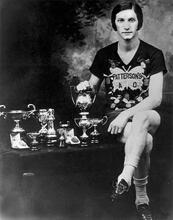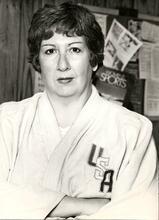Sport in Israel: Yishuv to the Early 21st Century
While it was no easy task for women to integrate successfully into the world of modern competitive sports, the number of competitive women athletes throughout the world has increased markedly. A similar development, though slower and with more modest achievements, has also occurred in sports in Israel. Women have been involved in sports in Israel since the Yishuv period, participating as teams, as individuals, and as coaches. The status of women in sport reflects their status in society at large. Though more women now participate in competitive sports, the field still reflects a masculine culture of power struggle and a desire to defeat the enemy. More recent political efforts in Israel have attempted to achieve women's equality in athletics.
Women and Sports in the Yishuv
The limited amount of information we have about women’s athletics during the Jewish community in Palestine prior to the establishment of the State of Israel. "Old Yishuv" refers to the Jewish community prior to 1882; "New Yishuv" to that following 1882.Yishuv period enables us to discern only a few significant milestones. The first item of such information on a woman’s achievement in an athletic event in Palestine comes from the Ha-Shomer organization and relates to Zipporah Zeid (1888–1968), wife of the noted Ha-Shomer member Alexander Zeid (1886–1938). Zipporah won much praise when she participated in a horseback-riding competition in the Rehovot Festival in the frame of which the first sport meetings in the country were held. Zeid related how during the A seven-day festival to commemorate the Exodus from Egypt (eight days outside Israel) beginning on the 15th day of the Hebrew month of Nissan. Also called the "Festival of Mazzot"; the "Festival of Spring"; Pesah.Passover 1912 festival she slipped into the horseback-riding competition at the last moment, riding a horse that belonged to her husband. She recounted how her opponent lagged behind and stopped the competition when he discovered that he was competing with a woman.
Among the many Jews who immigrated to Palestine from Europe during the 1930s were some women athletes who gave women’s sports a considerable boost. Sonia Levin-Schmuckler, a track and field athlete and basketball player from Poland, was a member of the Maccabi Club of Vilna and held a shot-put record of 12.21 meters that remained unsurpassed for twenty-five years. Swimmer Judith Deutsch-Haspel, a member of Ha-Koah in Vienna, came to Palestine after refusing (along with her colleagues Ruth Langer and Lucy Goldner) to represent Austria in the 1936 Nazi-sponsored Olympic games in Berlin. However, in the first two Maccabiah games held in 1932 and 1935, no woman from Palestine won a gold medal.
In 1934 Maccabi sent a team of twelve women from Palestine to the fourth Women’s World Games in London. Though the team’s achievements were poor, the significance of appearing in England’s capital reached far beyond the stadium walls. The fact that the Maccabi women of Palestine proudly bore the blue-and-white flag and the sign “Palestine” was seen as a significant national public-relations event and a historic milestone in the development of Yishuv sports. Yosef Yekutieli, a leader in Jewish sports of that period, wrote:
Bit by bit, step by step, we won our position in international sports. […] One result of this great work was the participation of the Maccabi women of Tel Aviv in the Women’s Olympics. In August 1934, the fourth Women’s “Olympics” were held in the White City Stadium in London. Our small country appeared among the world’s nineteen most famous nations. We were aware of our meager strength in athletics and especially that of our teammates even before we sent our sisters to the competition. […] But we have no reason to be ashamed of our team, which was chosen from a tiny reserve of Maccabi Palestine women, and this was its first international appearance. The first step had to be taken, and it was done with great success. Because our teammates’ duty in the athletic events themselves was lighter, the emphasis shifted to their representative participation in the event. In this appearance, the Maccabi Palestine women succeeded one hundred percent; they were one of the best-organized teams.
In the 1940s swimmer Aliza Wirtz joined the ranks of outstanding athletes, as did Raya Bronstein, the first “native talent” (though born in Germany) to participate in track, field, and basketball. Wirtz crossed the Kinneret with a winning time of three hours, 31 minutesm and 50 seconds. Bronstein and Frieda Berson-Lichtblau were candidates to represent Israel in the Olympic Games held in London in the summer of 1948. However, they were not allowed to participate because Britain claimed that Palestine, whose Olympic committee was recognized by the International Olympic Committee, had ceased to exist on May 15, 1948, while the Olympic Committee of the independent State of Israel had not yet been recognized.
Israeli Women in Team Sports
In 1950 the participation of the Israeli women’s basketball team in the championship of the continent called “Europe and the Mediterranean Basin” held in Budapest once and for all ensured the place of Israeli basketball in Europe. Because of its poor achievements in the championships, the women’s team did not participate in the European championships again until 1968. Moreover, during more than fifty years of the state’s existence the women’s team played fifteen percent fewer games than the men’s team. However, the precedent-setting appearance of the women’s team in Europe took on added significance when Israel was expelled from the world of Asian sports many years later, after the 1974 Asian Games. Women’s basketball has recently won greater public and media exposure. The level of the league is high compared to that of other team sports because of the strong foreign players who play for local teams.
Israeli women’s basketball teams participate in various European events. The outstanding achievements of two of the teams are noteworthy. In 1991 the women’s team reached the European championship finals, which were held in Israel, finishing in eighth place. In 1999, the A. S. Ramat ha-Sharon team played in the finals for the European Ronchetti Cup in basketball. (The previous year, the Elitzur Ramle women’s basketball team had reached the cup semifinals.) In the first game held in Israel against the Spanish team, Sandra Gran Canaria, the Israelis won 79–72, though they lost 64–54 in the return match in Spain and did not win the cup. Another noteworthy achievement was the victory of the women of Kiryat Sharett High School in Holon in the International High School Basketball Championships, which took place in Jerusalem in May 1999. Dozens of teams from abroad competed in the championships, in which the Israeli team won every game, defeating teams from Belgium, Slovakia, France, Germany and Hungary. In the finals they beat the strong team from Turkey.
Outstanding Israeli basketball players such as Anat Dreigor and Limor Mizrachi took their places in the high ranks of international basketball. Dreigor is considered Israel’s all-time greatest woman basketball player. In her twenty-year career she has scored about twenty thousand points and played in sixteen championship games and fourteen national cup games. In the 1980/1981 season Dreigor played on the French team Clermont-Ferrand, while during the 1991/1992 season she played for the Racing Club in Paris. Captain of the national women’s basketball team, she played in seventy-nine international games. In May 1994, several days after she led Elitzur Holon to win its eighteenth consecutive championship game, Dreigor announced her retirement from basketball. Limor Mizrahi, a native of Tel Aviv’s Ha-Tikvah neighborhood, grew up on that city’s Bnei Yehudah basketball team but attained her best achievements mostly on the Elitzur Ramle team. At the beginning of 1992 she was accepted to the University of Maryland’s basketball team in the United States, which was considered one of the best college women’s basketball teams and played there for several years. She also played in Iceland. During the 1999/2000 season, she joined the Nirosoft Karmiel team.
In 1967 the women’s volleyball team took second place in the European championships, the highest place of an Israeli national team in this field. Immediately after this impressive achievement the women’s team ceased activity on the departure of its coach, Arie Selinger, who went on to win a worldwide reputation. When the women’s volleyball team resumed activity two years later it participated in more than two hundred games.
The women’s handball league, which began its activity in 1963, played its first international game only a dozen years later. Since that time there has been a steady decrease in the number of women’s teams in the league. In 2005 there were only eleven active teams. The women’s team has played only nine international games since the state was founded and has had no noteworthy successes.
The 1990s saw discussions between the secretariat of the Israeli Football (Soccer) Association (I.F.A.) and the Lit. "assembly." The 120-member parliament of the State of Israel.Knesset Committee on the Status of Women regarding the promotion of women’s soccer in Israel. After approval of the program to promote it, the women’s soccer league was started for the first time in 1998. Yet a women’s international soccer team existed even before the league was founded and it played several international games. In 2005 there were eighteen female soccer teams active within the framework of the I.F.A. The Maccabi Haifa team won the first national championship in the 1998/1999 season, after it defeated Hapoel Tel Aviv, among whose teammates was the outstanding player Silvie Jean. Jean also played in Norway where, as in Israel, she was considered a prolific pioneer and well-liked star. The 2005 champion is the Maccabi team of Holon. To date, the women’s team has not scored any significant achievements. In the first friendly games Lilach Assoulin served as referee. Since then, she has refereed men’s games, mostly in the minor leagues.
Israeli Athletes in Individual Sports
Since the founding of the state, women have been active mostly in individual competitive sports. Most of the better-known achievements of Israeli individual athletics have been accomplished by women, two of whom stand out especially in women’s sports in Israel: Esther Roth-Shachamorov and Yael Arad.
Esther Roth-Shachamorov competed in track and field events, short-distance running and the long jump. She won two gold medals in the Asian Games in Bangkok in 1970 (for the 100-meter hurdles and the pentathlon) and a silver medal in the long jump. Four years later, in the Asian Games in Tehran, she won three gold medals for short-distance running. Chosen as Athlete of the Year in Asia in 1971, Roth-Shachamorov was a record-holder for the continent in short-distance running and hurdles. Participating in the 1972 and 1976 Olympic Games, she was the first runner to represent Israel in the Olympic finals (100-meter hurdles in Montreal, 1976), winning sixth place. Roth-Shachamorov held the Israeli record in the long jump for fifteen years and has for more than twenty years held the Israeli records in the 100-meter and 200-meter dashes and the 100-meter hurdles. Roth-Shachamorov received the medal of the Olympic Order after she returned to the Olympic Games with success and pride after her coach, Amitzur Shapira, was one of the eleven Israeli athletes murdered during the Olympic Games in Munich in 1972. That incident compelled her to leave the games before they ended. She continued to train with Peter Roth, whom she eventually married. Esther Roth-Shachamorov is one of two Israeli athletes to have won the Olympic Order and in 1999 she was awarded the Israel Prize. Today Roth-Shachamorov is a member of the Israeli Olympic Committee. In Heroes of Israel (1988), Yoram Arbel dubbed Roth-Shachamorov “the fastest woman in the Western world,” and Michael Bar-Zohar, the book’s editor, added:
Esther wanted to do sports. From childhood, she dreamed of teaching sports in school, and after she transferred from a religious school in the Shapira neighborhood to the state school in Kiryat Shalom, she systematically broke every record in the school races, of the boys and girls in her class and the older classes. … Perhaps then, when she was still wild and natural, she would have won in Mexico too, if she had not strained a muscle and been forced to postpone her international competition. She was not broken, either by that disappointment or by the catastrophe in Munich or the disappointment that came afterward, and not even by the cancellation of the participation in the Moscow Olympics. Indeed, for a few years she was the fastest woman in the Western world; the few who beat her were Eastern Europeans. … She is convinced that she would have defeated them as well in the end if she had only had opportunities to compete like them.
Yael Arad is a judoka. Her outstanding accomplishments in the international arena deserve high praise. In 1984, when she was seventeen, she competed in the world judo championships held in Vienna and came in seventh. In 1989, 1990 and 1991 Arad won medals in the European championships. In 1992 she won a silver medal in the Olympic Games held in Barcelona after losing in the finals to Catherine Fleury of France. The only silver medal and “the most precious” that Israel won that year, it is one of six Olympic medals that Israeli athletes have won thus far. In 1993 Yael Arad won a gold medal in the European championships and a silver medal in the world championships, where she lost in the finals to Gella van de Caveye of Belgium. In 1996 Arad lost to the Korean judoka Sung Sook Jung in a fight for the bronze medal. Today she is a member of the Israeli Olympic Committee and a senior coach for the next generation of judokas.
Yael Arad later wrote about the historic night she won the Olympic medal, which stirred the whole country to pride and excitement:
Thursday, July 30, 1992. A fateful day, a watershed day, a day of fame, a day of self-fulfillment. A day that required fifteen years of hard work, endless investment and hidden self-confidence. The day I won the Olympic silver medal. My medal. The first medal of the State of Israel. … I went onto the mat like a stormy wind, after a warm-up that drove from my body all the little demons that threatened to defeat me even before it all began. The first match was against a woman from Spain who had already defeated me twice in the past, but it was clear to me that this time she had no chance. I went off after four minutes, the winner. The second match was against a woman from the Czech Republic. We knew each other well and we both knew I was better. The victory over her contributed a bit more to building confidence for the tough and significant match of the day. Four minutes were all that stood between myself and my life’s dream. … When the match started, the semi-finals, I was there with all my battle gear. And suddenly, it was all over. I had won. … Emotionally it was the highest moment of my life and despite my losing later in the finals the victory in the semi-finals against the woman from Germany was the sweetest of all. That day I changed from a person who wanted to a person who could. And that made all the difference.
Other women athletes worthy of mention are:
Ahuva Kraus-Kravitzky, a high-jumper who won the gold medal in the Asian Games in Manila in 1954. She writes of her victory:
Even though we were the smallest delegation, we got lots of attention. We felt a lot of apprehension. The heat was unbearable. I knew very well that the strongest opponents awaited me, especially two Japanese women who had passed 1.50 meters many times already. I stepped onto the field with mixed feelings: apprehension and a strong desire to win. … I won! I broke the Asian high-jump record, I had won the gold medal. … A military band began to play “Ha-Tikvah” and the Israeli flag began to ascend the pole. I choked with excitement.
Devora (Debbie) Turner-Marcus, a runner, won the gold medal in the 200-meter dash and a bronze medal in the 100-meter dash in the Asian Games held in Bangkok in 1966. A native of London, she came to the Maccabiah Games in 1957 as a member of the British team. With supreme effort she later succeeded in overcoming polio and returning to Israel as a participant in the 1961 Maccabiah Games, in which she won the 100-meter dash. A few days later she decided to move to Israel and worked as a high-school physical education teacher. At the same time, she worked with disabled children, increasing their athletic abilities. She was named Israeli Sportswoman of the Year in 1966.
Hana Shezifi, a middle- and long-distance runner (800 meters, 1500 meters, and 3000 meters), won four medals, three of gold and one of bronze, in the Asian Games in 1966, 1970 and 1974. She also won two bronze medals in the Asian championships held in Seoul in 1975. Shezifi participated in the Maccabiah Games and the Hapoel Games, winning first place in both. She represented Israel in the Olympic Games in Mexico City (1968) and was named Athlete of the Year in 1970.
Orit Abramovitch, a high-jumper, won a gold medal in the Asian championships in Manila in 1973 and also won a gold medal in the Asian Games held in Tehran in 1974. When she was fourteen, she broke the national high-jump record for the first time. At age sixteen she won the Asian championships, crossing 1.68 meters. Abramovitch was named Outstanding Israeli Athlete in 1973.
Fencer Lydia Hatuel-Zuckerman represented Israel in the Olympic Games in Los Angeles (1984), Barcelona (1992) and Atlanta (1996). She is one of the four athletes who have represented Israel three times or more in the Olympic Games. Additional repeaters at the Olympic Games include fencers Nilli Drori (1976, 1984) and Ayelet Ohayon (2000, 2004), as well as swimmer Shlomit Nir (1968, 1972).
Anat Fabrikant (b. 1975) and Shani Kedmi (b. 1977), the 470 double-handed dinghy sailing team, won worldwide high ranking in the second half of the 1990s. The two missed winning a medal in the 2000 Olympics, coming in fourth place.
Zippora Rosenbaum-Rubin (b. 1946), an outstanding handicapped athlete, took part in seven Paralympics in the years 1964–1988, winning many international gold medals in the discus throw and the shot put. She was the Paralympics javelin champion seven consecutive times, almost each time breaking both the Games and the world record. She reached the peak of her career in 1976 in the Paralympic Games held in Toronto, where she won four gold medals. In addition to track and field Rubin also participated in swimming, fencing and basketball. She received much encouragement and promotion from her track and field coach, the gifted former track and field athlete Edna Medalia. Zippora Rosenbaum-Rubin exemplifies the victory of the will over the body’s limitations.
Keren Leibowitz is an outstanding swimmer with splendid achievements in the 2000 Paralympics in Sydney. She won three gold medals and set three world records in swimming. During the 2004 Paralympic Games Leibowitz received four medals—one gold, two silvers and a bronze. Keren Leibowitz often says that she should be treated as an ordinary athlete and not a handicapped one and that “the value of [her] athletic achievement is no greater than that of an ordinary athlete.”
The collapse of the Communist regimes in Eastern Europe at the end of the 1980s and the beginning of the 1990s led to a large wave of immigration from the CIS, providing new opportunities for the State of Israel in sports. Among the outstanding athletes who immigrated are swimmers Timea Toth and Anja Gostomelsky, rhythmic gymnast Or Tokayev, markswoman Yelena Tripolsky, tennis player Anna Smashnova and kayak rower Larissa Pesakhovitch.
Fifty-nine female athletes have represented Israel in the last fourteen Olympic Games, from Helsinki (1952) to Athens (2004). The pioneers were the track and field athletes Leah Horowitz-Simri, Tamar Metal-Shumacher and Olga Winterberg. Throughout the years Israel has been represented in the Olympic Summer and Winter Games by female athletes in twelve sports: canoeing, fencing, gymnastics, judo, sailing, shooting, swimming, table tennis, Tae Kwan-do, tennis, track and field, as well as in figure skating in the Winter Games.
High-Level Athletic Coaches
In the first years of the state’s existence, sportswomen of the highest ranks with notable athletic backgrounds and world-class achievements arrived in the country. They brought much honor to the country and bore the brunt of grooming and training future sportswomen in the different fields. Two of the most outstanding among them are Agnes Keleti and Angelica Rozeanu.
Agnes Keleti, known as Aggie, began her career as a gymnast in Hungary before World War II. In fascist Hungary she was forced to give up competing and only after the war did she return to the gymnastics floor to make up for the years she had missed. Keleti was considered a top-ranking athlete in Hungary and even outside it after winning in dozens of competitions, national championships, the Olympic Games and world championships. As a representative of Hungary, she won five Olympic gold medals, three silver ones and two bronze in the Games held in Helsinki (1952) and Melbourne (1956). During the Olympic Games in Melbourne, affected by the Hungarian uprising against the Communist regime that began at the time, she decided never to return to Budapest. Instead, she immigrated to Israel, where she was received with much enthusiasm. She appeared in gymnastics exhibitions in the fifth Maccabiah Games (1957), amazing spectators with her ability and skill. Since then Keleti, with her persistence and toughness, has devoted herself to Israeli sports activities and has served as a coach for the national women’s team for more than two decades. She also trained physical education teachers at the Wingate Institute and groomed gifted sportswomen in gymnastics.
Angelica Rozeanu, a native of Bucharest, is considered one of the best table tennis players of all time. She represented Romania in many international competitions and gained unprecedented achievements, winning seventeen world championship titles, among them six in a row in individual games (1950–1955). When she immigrated to Israel in 1960 she continued to take an active part in table tennis and won the national championships in 1960–1962, also winning the Maccabiah championship title and the 1961 Hapoel Games. Rozeanu was the first Israeli sportswoman to play in the men’s league for lack of an appropriate woman competitor. In 1964 Rozeanu was appointed coach for the Israeli men’s table tennis team. This appointment caused a furor when the members of Maccabi claimed that Hapoel had made an arbitrary decision that would not benefit the sport. The real reason for their anger was the replacement of coach Otto Pfefferbaum, who was much admired by Maccabi and who, they claimed, had been dismissed without sufficient reason. Some players resigned from the team, but ultimately agreed to return. The incident was a great embarrassment to Rozeanu, who did not remain long in the position.
The new generation gave rise to its own coach, who brought her team to impressive achievements. Orna Ostfeld, a former member of the Israeli basketball team and listed in the Guinness Book of World Records for scoring 108 points in a single game, was chosen as coach for the A. S. Ramat ha-Sharon team and led it to many victories. Most impressive of them was their historic victory in the European Ronchetti Cup basketball championships in 1999. Although the Israeli women’s team fell short in the finals, they won the support of thousands of sports devotees after they went from being an anonymous team to one courted by the media. They have since won their league’s championship in 2003 and 2004.
The Position of Women’s Sport in the State of Israel
The status of women in sport reflects their status in society at large. Though more women are now participating in competitive sports, the field still reflects a masculine culture of power struggle and a desire to defeat the enemy. The careers of women athletes tend to be shorter than those of men and less rich in professional recompense.
Research by Michael Bar-Eli, Adra Spiegel and Michal Ya’aron (1998) shows that since the 1980s the representation of Israeli women in the Olympic Games and the Maccabiah Games has increased, though Israeli athletes are still underrepresented in those events. There is a large and fairly stable gap (of about sixty-five percent throughout the years) favoring men over women in the Olympic Games, and a smaller but fairly stable gap (of about fifty percent throughout the years) favoring men over women in the Maccabiah Games. The data show that the ratio of men to women who participated in the Olympic Games was 4.5:1, and in the Maccabiah Games 3:1. The difference in the data between the two competitive institutions apparently derives from the fact that the Olympic Games are events of athletic achievement of a higher competitive-representative level than the Maccabiah Games and thus more professional.
Since the establishment of the state there has been marked inequality in the opportunities for women in athletics. Already at the beginning of the 1960s, in light of discrimination against women in sports, the leading sports organization of the day, Hapoel, founded a special department to promote women’s sports. This department was active within Hapoel in particular and in the service of Israeli sports in general. It ceased operations after a few years without having any significant effect. Women make up only twenty-five percent of the general population of active athletes in Israeli competitive sports (a much lower number than the average in the Western world and also less than the lower world average). For more than four decades women athletes have “merited” systematic representative and financial discrimination despite their achievements in international sports, from the Asian Games to the Olympics. Not only are their achievements no lower than those of the men, but in many cases they are higher. Reduced budgets lead to a decrease in achievements and thus to less interest among the public. If budgets are increased, women athletes will be able to improve their abilities, be compensated appropriately and increase their motivation. Their achievements will result in greater exposure among the public and in the media, along with remuneration from advertisers and sponsors. In the 1990s discrimination against the Israeli women’s fencing team was blatant. In 1991, the fencing team came in ninth place in the world championships and following that was invited to compete in the 1992 Olympic Games in Barcelona. However, the team was sent to represent Israel in the Olympic Games only four years later, in Atlanta.
Women’s representation in Israeli sports organizations was minimal and remains so to this day. One can find a characteristic example of this situation in the organization of physical education teachers, the majority of whose members are women. Since the organization’s founding in 1927, only one woman has led it (Ita Simri, who did so from 1982 to 1994), while in the central forums of the organization women were always a minority. In the Olympic Committee Board of Directors, which has thirty-one members, there are only two women, Dafna Har-Even and Lydia Hatuel-Zuckerman. Two additional women, Hana Shezifi and Maya Cale-Ben Zur, were brought in as “permanent guests.”
The founding in 1985 of the non-profit organization Lakhen, an acronym for the Hebrew words for Promotion of Women’s Basketball, contributed much to changing this reality. The background of its founding was the discrimination against the Israeli women’s basketball team as expressed during the twelfth Maccabiah Games in 1985. The women’s championship final between the Israeli and USA teams was supposed to take place in the Yad Eliyahu stadium before the men’s finals. After it was decided to move the women’s finals to a space in the Maccabiah Village, the Israeli players decided to boycott the game in protest and the American team joined them in solidarity. In a unanimous decision of the Basketball Association the Israeli team was disbanded as punishment for their boycott. In response, senior basketball players of the past and the present, among them Orna Ostfeld, Anat Dreigor, Leah Melamed, Ronit Yinitzky and the late Ralli Dirx established Lakhen, which appealed to the court, claiming that collective punishment should not be permitted. The appeal’s success enabled the Lakhen organization to continue the activity of the women’s basketball team; six years later it attained the pinnacle of its achievements when it reached the European team championship finals. In 1989 the organization appealed to the courts demanding that the Basketball Union make the women’s league equal in constitution to the men’s league. The significance lay in the participation of two foreign players in the women’s league, which was forbidden until the appeal was presented. At the end of prolonged deliberations, the two foreign players were allowed to join the team, which contributed a great deal to the improvement of Israeli women’s basketball. In addition, the members of the Lakhen organization continue to persist in putting matters pertinent to the encouragement of women’s athletics on the public agenda and work for increased media exposure for Israeli women’s basketball. There is no doubt that their work constitutes the climax of women’s struggle for equality in Israeli sports.
Another group whose goal is promoting women in Israeli sports is the School Sport Association, which was founded in the mid-1990s and strengthens the human infrastructure of sports in the country. As part of its activities, the association organizes all the intramural championships, in which thousands of high-school pupils, both male and female, participate every year. The athletics association, which is active in thirteen different sports, has set itself several athletic, ethical and social goals. Among these is an increase in the number of girls and young women involved in sports. There are also three secondary goals: 1. Equality between the number of girls and the number of boys involved in sports, with emphasis on encouraging girls aged seven to twelve (before they reach puberty) to play sports, since at that age it is easier to shape opinions, form habits, develop areas of athletic activity and create the basis for moderate and gradual change, which will result in an increase in the proportion of women who participate in sports. 2. Leadership training for skilled women who will thus be equipped to fill senior management positions in Israeli sports. 3. Influencing the attitudes of school principals so that they feel positive about fostering athletics teams in schools as part of the task of the educational system.
Economic and societal changes in the past decade and the entrance of many more women into the work force have led to changes in women’s attitude toward sports and their potential benefits. Israeli society has begun to show “awareness” regarding women’s place in sports. Between 1993 and 1998 four government committees (Maliniak, Dekel, Ben-Dror and Levin) dealt with the subject of national sports, all of them even giving attention to the subject of women’s sports. The Committee to Reform the Structure of Athletics in Israel, headed by Aryeh Maliniak, which presented its recommendations in 1993, determined that although women make up fifty-one percent of the population, only twenty-five percent of those who participate in sports are women. It appears that the percentage of women involved in popular mass activities is higher than that of men. In competitive sports, women participate mostly in individual sports such as light track and field, swimming, judo and fencing, as well as in basketball. The committee found that women’s sports are unique in terms of their requirements and recommended that the infrastructure of women’s sports be expanded for youth, to increase awareness of sports among women and work to raise the level of women athletes in the competitive fields. The committee also recommended that an independent department be opened for women’s sports.
In 1994 the Deputy Director General of the Ministry of Education, Culture and Sports, and the director of the Sport and Physical Education Authority, Yehoshua Dekel, who headed another committee, announced that the promotion of women in sports was among their main goals. To this end, a special department was created within the authority and Shlomit Nir-Tor, a former outstanding swimmer, was appointed to head it. The department’s goals include increasing the number of girls, teenagers and women in sports in general and competitive sports in particular; increasing the number of active coaches; increasing the number of women decision-makers on boards of directors and in various sports organizations; forming a special medical committee to deal with the various needs of women athletes at all levels; and the forming of the non-profit Organization for the Promotion of Women in Israeli Sports.
In 1994 the measures taken to achieve women’s equality with men in athletics led to the decision of the committee headed by retired judge Mordechai Ben-Dror that National Lottery budget allocations for men’s and women’s athletics must be equal. In the Schools’ Athletics Union, preference was given to girls’ sports, a preference expressed by granting priorities and setting aside budgets for competitive women’s sports teams.
The series of committees formed in the State of Israel during the last decade of the twentieth century to discuss the promotion of women’s sports, and the fact that they reiterate the recommendations of earlier committees, attests to the fact that the problem of the status of women’s sports in Israel is still far from being solved.
A further step taken by the Minister of Education, Culture and Sports in 2005 demanding that the Sports Betting Board allocate special funds for the promotion of female competitive sports.
Following two decades of a public campaign to gain equal rights for women in the area of sports, one of the leaders of the campaign in the U.S., the famous tennis player Billie Jean King, was able to declare, “You’ve come a long way, baby.” It seems that Israel’s women still have a long way to reach a similar status.
Kaufman, H, and H. Hariff. Physical Culture and Sport in Israel in the Twentieth Century. Jerusalem: 2002.
Porat, J., and M. Lehrer. “Sport 50.” Ma’ariv, 1998.
Simri, U. One Hundred Years of the Olympic Movement. Tel Aviv: 1944.
Simri, U. and I. Paz. Forty Years of Sports in Israel. Tel Aviv: 1988.


